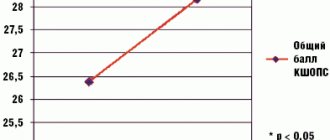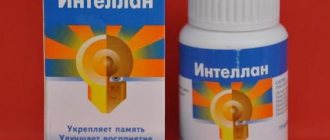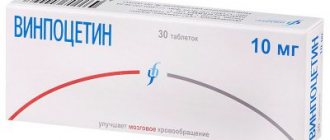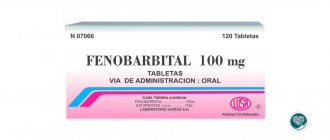Pharmacological action of Valium
The active substance of Valium, diazepam, has a pronounced sedative, muscle relaxant, hypnotic and anticonvulsant effect. During therapy, blood vessels dilate, resulting in a decrease in blood pressure. The drug is effective for the treatment of convulsive paroxysms associated with epilepsy, obsessive and phobic disorders, and sleep disorders.
The medication is used orally, intravenously and intramuscularly, with a sedative effect developing most quickly after intravenous administration (within a few minutes). According to the instructions, Valium has a stable therapeutic effect after 2-7 days of use. When using the medication against the background of withdrawal syndrome that develops with chronic alcoholism, the medication helps get rid of hallucinations and reduce the severity of other symptoms - tremor, agitation and delirium.
Expert opinion
Reviews from doctors who use Valium in their practice.
I often use Valium in my practice to treat patients with alcohol addiction. I am personally convinced that the drug is highly effective, allows you to quickly relieve withdrawal symptoms and alleviate the patient’s condition.
Dorokhov A.O., narcologist
This medication has proven itself in the treatment of psychosomatic and post-traumatic disorders. I usually prescribe a course of the drug to my patients to achieve sedation, relieve anxiety and improve the quality of night sleep.
Nikitenko B.E., psychotherapist
Indications for use of Valium
Valium solution, dragees and tablets are prescribed according to the instructions for the treatment of:
- Anxiety disorders (usually as part of a combination treatment);
- Dysphoria;
- Insomnia;
- Skeletal muscle spasm;
- Tension headaches;
- Spastic conditions that are associated with damage to the spinal cord or brain, for example, tetanus, athetosis, cerebral palsy;
- Rheumatic pelvispondyloarthritis, myositis, arthritis, bursitis, progressive chronic polyarthritis;
- Arthrosis, accompanied by tension in the skeletal muscles;
- Vertebral syndrome;
- Angina pectoris;
- Alcohol withdrawal syndrome, including tension, anxiety, agitation, tremor and transient reactive states.
As part of complex therapy, Valium tablets are usually used to treat:
- Arterial hypertension;
- Meniere's disease;
- Peptic ulcer of the stomach and duodenum;
- Status epilepticus;
- Psychosomatic disorders in gynecology and obstetrics, including gestosis and menopausal and menstrual disorders;
- Eczema and other diseases that are accompanied by irritability and itching;
- Drug poisoning.
The medication is also used for premedication before operations and endoscopic procedures, general anesthesia.
Injections with Valium solution are used:
- When conducting medicinal preparation for general anesthesia;
- As a component of combined general anesthesia;
- As part of combination therapy in the treatment of myocardial infarction;
- In psychiatry and neurology in the treatment of motor agitation of various etiologies;
- In paranoid-hallucinatory states;
- To relieve epileptic seizures;
- To facilitate labor;
- During premature birth at the end of the third trimester of pregnancy, as well as premature placental abruption.
Interaction with other medications
The drug "Valium" causes potentiation of the effects of alcohol, hypnotics, anticonvulsants, hypotensive and antihistamines, as well as neuroleptics, general anesthetics, tricyclic antidepressants, muscle relaxants and analgesics.
Psychostimulants and analeptics can significantly reduce the activity of the drug "Diazepam".
Antacids reduce the rate, but not the level, of absorption of this drug.
Microsomal oxidation inhibitors such as Cimetidine, Omeprazole, Ketoconazole, Fluoxetine and Fluvoxamine change the pharmacokinetics of the drug in question and also increase the duration of its clinical effects.
"Rifampicin" reduces con in the blood, and "Erythromycin" slows down its metabolism in the liver.
Contraindications
Contraindications to the use of Valium are:
- State of shock;
- Coma;
- Acute alcohol and drug poisoning;
- Hypersensitivity to active (diazepam) or excipients;
- Myasthenia;
- Acute respiratory failure;
- Severe chronic obstructive pulmonary disease.
Also, the medication is not prescribed to pregnant and lactating women. In pediatrics, the prescription of Valium according to the instructions is possible for children starting from six months.
Drug overdose
An overdose of the drug in question is accompanied by such an unpleasant symptom as central nervous system depression. This phenomenon can have varying severity, ranging from drowsiness to coma. Also, when taking large dosages of the drug, the patient may experience hypotension, confusion and respiratory depression.
Treatment of such conditions, provided that the patient is conscious, involves the induction of vomiting and the use of activated charcoal. If the patient is unconscious, his stomach is lavaged with a tube, and symptomatic therapy, vital signs screening, and fluid administration are performed to increase diuresis.
To stop the patient's excessive agitation, barbiturates can be prescribed.
How to use Valium
The treatment regimen for Valium tablets depends on the disease and the patient’s response to the therapy. As a rule, the medication is used in the treatment of:
- Hypochondriacal and hysterical reactions, neurological degenerative diseases, neuroses, dysphoria and phobias - up to 3 times a day, 5-10 mg;
- Alcohol withdrawal syndrome - during the first day, 10 mg 3-4 times a day. In subsequent days, the dose should be halved without reducing the frequency of use;
- Menopausal, menstrual, psychosomatic disorders and gestosis - three times a day, 2-5 mg;
- Angina pectoris and high blood pressure – 2-5 mg three times a day;
- Vertebral syndrome - 10 mg four times a day with bed rest;
- Arthrosis, chronic polyarthritis – 5 mg. The frequency of use can vary from 1 to 4 times a day.
At the beginning of therapy for atherosclerosis, elderly people, as well as patients weakened by the disease, are prescribed Valium in a dosage not exceeding 2 mg twice a day.
For children 1-3 years old, Valium tablets are prescribed 1 mg, for children 3-7 years old - 2 mg, for older children - 3-5 mg. In some cases, for example, with severe epileptic seizures, motor agitation, spinal cord injuries, it may be necessary to administer the drug intravenously or intramuscularly.
The medication is administered intramuscularly for heart attack and preeclampsia at the beginning of treatment in an amount of 10 mg, after which Valium tablets are taken 5-10 mg one to three times a day.
To facilitate labor, after opening the cervix by 2-3 cm, 20 mg of the drug is administered intramuscularly. In case of premature birth, if placental abruption occurs prematurely, 20 mg of Valium is also administered. If necessary, the same dose is administered again after an hour. In addition, injections of Valium solution are used for anesthesia, in the treatment of spastic conditions of rheumatic origin and vertebral syndrome.
Kinetics
The medication "Valium", analogues of which are listed below, is absorbed from the gastrointestinal tract (when taken orally). In this case, absorption occurs by 75%, and the maximum concentration is reached after 1.5 hours.
The biological transformation of this medicine occurs in the liver. In this case, active metabolites with a half-life are formed. When prescribing the medication to infants, the effect is achieved after 30 hours, and for elderly and adults – after 100 and 48 hours, respectively. In case of liver pathologies, this indicator is extended to 4 days.
The drug in question is excreted from the human body mainly by the kidneys (90%) in the form of conjugates, as well as unchanged (2%) and together with feces (8%).
Side effects
At the beginning of therapy with Valium, according to reviews, the following may be observed:
- Drowsiness;
- Dizziness;
- Disorientation;
- Increased fatigue;
- Lethargy;
- Poor coordination of movements;
- Slowing of motor and mental reactions;
- Retrograde amnesia;
- Decreased attention.
In some cases, euphoria, muscle spasms, tremors, headache, depression, confusion, depression, dysarthria, weakness, hallucinations, catalepsy, agitation, fear, anxiety, irritability, insomnia and other mental and nervous system disorders may occur.
In addition, according to reviews, taking Valium can lead to the development of disorders from:
- Digestive system: in the form of heartburn; constipation; hiccups; nausea; vomiting; dry mouth;
- Cardiovascular system: in the form of tachycardia; reducing blood pressure; thrombosis
In especially severe cases, Valium, according to reviews, causes breathing and vision problems. Also, the medication can lead to addiction, and its abrupt withdrawal can lead to a worsening of the condition. Therefore, it is not recommended to purchase and take Valium without a prescription, and the treatment course must be fully agreed with the attending physician.
Purchase and storage of the drug
This medication should be stored in a dark and cool place, protected from children. The medicine should not be used after four years from the date of manufacture.
Valium is a potent drug that can have a narcotic effect, so in Russia it can only be purchased with a prescription written by your doctor.
The price of a package of foreign Valium Roche is 230 pounds sterling for 1000 tablets of 10 mg, the domestic drug can be found for 1000 rubles.
The most accessible analogues of Valium are Diazepam, Relanium, Sibazon and other benzodiazepine drugs.
Release form
Diazepam is one of the items on the list of the minimum set of drugs determined by WHO. This remedy is used to treat the following diseases:
- anxiety;
- insomnia;
- epileptic seizures;
- muscle spasms;
- alcohol addiction.
The drug may be recommended for use in preparation for some medical procedures for the purpose of anesthesia or sedation of patients.
Valium is sold in the form of injectable solutions and tablets . As for the solution, 1 ml contains 5 mg of diazepam. Such medicines go on sale in quantities of 50 or 10 ampoules made of dark glass. Each holds 2 ml of solution. Ampoules are placed in cardboard packaging. The tablets contain 5 or 10 mg of diazepam and some other ingredients, which include:
- corn starch;
- anhydrous lactose;
- calcium stearate;
- gelatinized starch;
- dyes.
Does methadone help treat heroin addiction?
Since methadone is officially prohibited in Russia and is included in the list of narcotic substances, we do not have programs in our country to combat heroin addiction using methadone. But it has quite extensive use in countries such as: Thailand, the Netherlands, Great Britain, Sweden, Canada and Australia. Methadone is included in special anti-drug programs there. Earlier, in the 60s of the last century, doctors in the United States of America were pioneers in the use of methadone in the fight against drug addiction.
In our country, the topic of using methadone within the framework of government programs is quite actively discussed, but there is no consensus yet. Various specialized UN committees and the World Health Organization have repeatedly called on Russia to start using this drug in the fight against drug addiction. This method has not yet been tested in our country. The main argument here is the fact that replacing one powerful drug with another, even stronger one, will be a mistake.
However, the methadone program is already being phased out in the United States, and clear positive results from methadone therapy have been noted only in Sweden. Moreover, one cannot help but note the fact that, for example, in the United States, there are more deaths from methadone overdose than cocaine and heroin combined. Opponents of methadone therapy describe its promotion as a drug as drug propaganda.
Here are a few reasons why methadone programs are not accepted in Russia:
- Methadone is cheaper and easier to produce than heroin
- Treating addiction to methadone is much more difficult and takes longer than to treat any other opiate.
- Methadone use is even more harmful to the body than heroin use.
- The dose of methadone must be strictly regulated by doctors, since exceeding it will almost certainly threaten the patient with death. Due to the ability of methadone to accumulate in body tissues, the dose will quickly increase, and the intervals between doses will inevitably decrease









